
Introduction
Yoga and climbing may seem like different disciplines, but they complement each other in numerous ways. Yoga can significantly benefit climbers by improving strength, flexibility, balance, mental focus, and breath control. In this article, we will explore the connection between yoga and climbing, the specific benefits of yoga for climbers, and how to integrate yoga into your climbing routine.
Understanding the Synergy
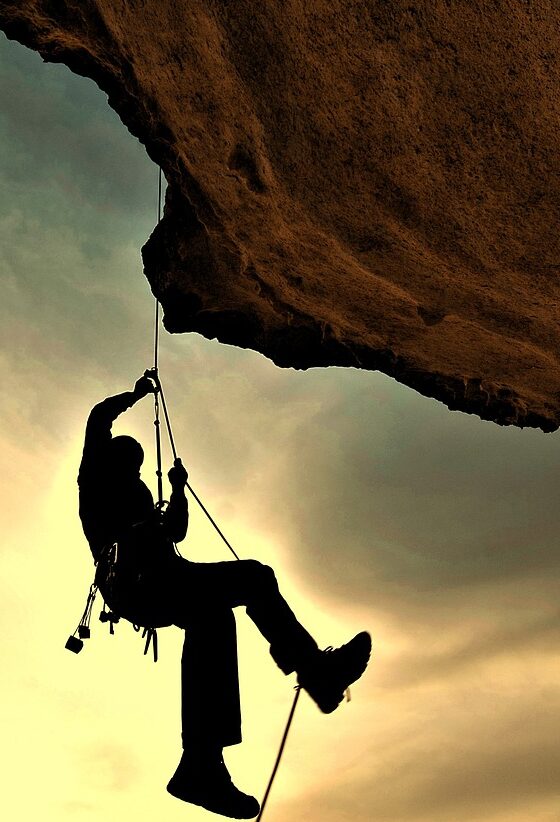
Climbing requires physical strength, flexibility, and mental fortitude. Yoga, with its emphasis on body awareness, breath control, and mindfulness, can enhance these qualities and provide climbers with an edge. By integrating yoga into your training routine, you can optimize your performance and reduce the risk of injuries.
Building Strength
1. Core Strength
Yoga poses such as Plank, Boat Pose, and Side Plank target the core muscles, which are crucial for stability and balance during climbing. By incorporating these poses into your yoga practice, you can develop a strong and stable core, aiding your climbing movements and preventing strain on other muscles.
2. Upper Body Strength
Certain yoga poses, such as Downward Dog, Chaturanga, and Crow Pose, engage the muscles in the arms, shoulders, and chest. Regular practice of these poses can improve your upper body strength, allowing you to perform demanding climbing maneuvers with greater ease and efficiency.
3. Grip Strength
Yoga poses that involve holding onto props or using the strength of your fingers, such as Handstand, help to develop grip strength. A strong grip is essential for maintaining a secure hold on climbing holds, making yoga a valuable tool for climbers.
Enhancing Flexibility
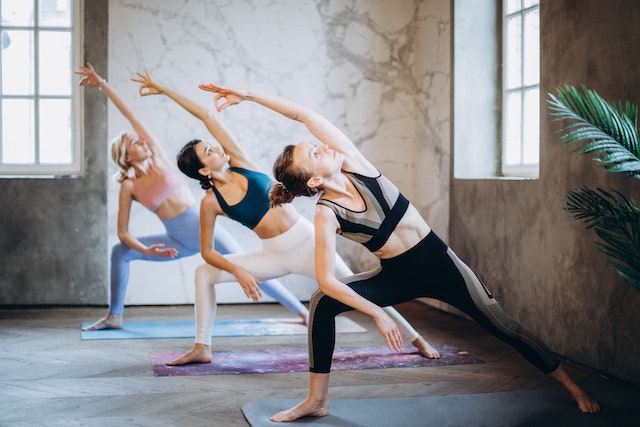
1. Hip and Leg Flexibility
Yoga poses like Pigeon Pose, Butterfly Pose, and Warrior Poses target the hips and legs, increasing flexibility in these areas. Improved hip and leg flexibility can enhance your ability to execute high steps, heel hooks, and dynamic movements while climbing.
2. Shoulder and Back Flexibility
Yoga poses that open the shoulders and elongate the spine, such as Camel Pose, Bridge Pose, and Cow Face Pose, help improve shoulder and back flexibility. This increased range of motion can aid in reaching for holds, maintaining balance on challenging routes, and preventing muscle imbalances.
Cultivating Balance and Body Awareness
1. Balance Poses
Yoga offers a variety of balance poses, such as Tree Pose, Warrior III, and Eagle Pose. Practicing these poses can improve your balance and proprioception, essential for navigating uneven terrain and maintaining stability on the wall.
2. Body Awareness
Yoga encourages deep body awareness by focusing on alignment, sensations, and breath. Developing body awareness through yoga can enhance your ability to listen to your body’s signals, recognize limitations, and prevent overexertion or injuries while climbing.
Mental Focus and Breath Control
1. Mindfulness Meditation
Incorporating mindfulness meditation into your yoga practice can sharpen your mental focus and help you stay present while climbing. By training your mind to stay focused on the present moment, you can improve your decision-making, manage fear, and enhance your overall climbing performance.
2. Breathing Techniques
Yoga teaches various breathing techniques, such as Ujjayi Breath and Three-Part Breath, that can regulate your breath and help you stay calm during challenging climbs. Proper breathing techniques can provide you with a steady supply of oxygen, improve endurance, and reduce anxiety on the wall.
Integrating Yoga into Your Climbing Routine
1. Pre-Climbing Warm-up
Before your climbing session, incorporate a short yoga warm-up routine to prepare your body and mind. Include dynamic stretches, gentle twists, and deep breathing exercises to activate your muscles, increase blood flow, and focus your attention.
2. Post-Climbing Stretching and Recovery
After climbing, dedicate time to stretch and cool down your muscles. Yoga poses like Child’s Pose, Thread the Needle, and Legs-Up-The-Wall can help release tension, improve circulation, and promote recovery.
3. Supplemental Training Days
On rest days or non-climbing days, consider adding a longer yoga session to supplement your training. Focus on poses that target specific areas of weakness or tightness, addressing imbalances and enhancing overall performance.
Yoga Poses for Climbers
To further assist climbers in integrating yoga into their training, here are some specific yoga poses that target the areas commonly used and strained during climbing:
1. Downward Dog (Adho Mukha Svanasana)
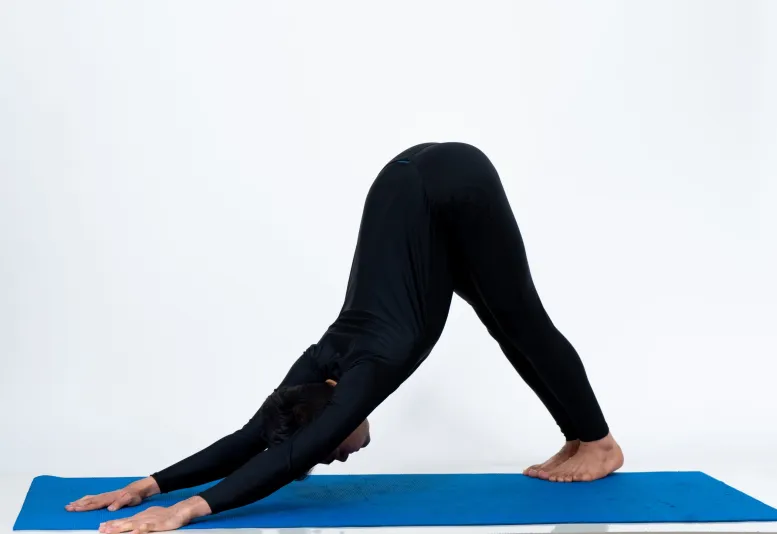
Downward Dog is a foundational pose that stretches the hamstrings, calves, and shoulders. It also helps strengthen the arms, wrists, and core. Practicing Downward Dog regularly can improve shoulder and upper body flexibility, which is crucial for reaching holds and maintaining stability while climbing.
2. Warrior II (Virabhadrasana II)
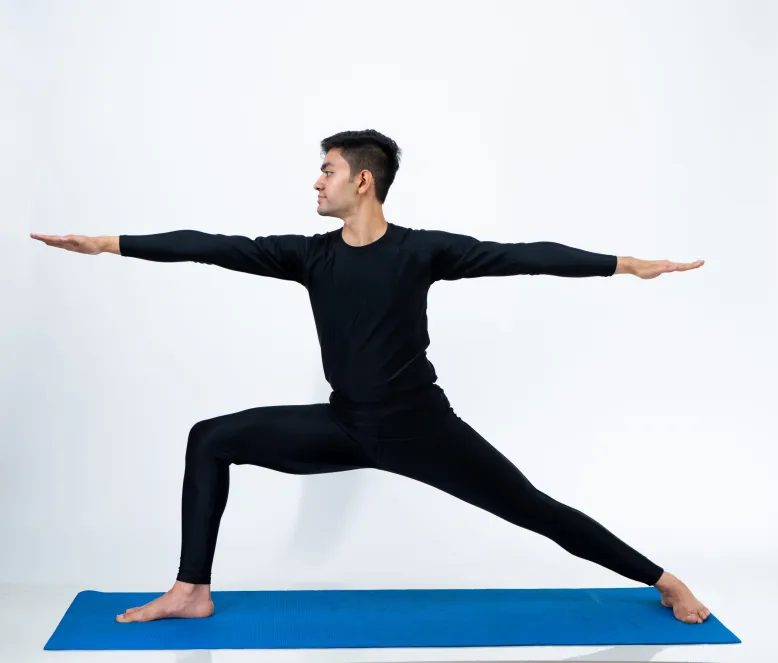
Warrior II is a powerful standing pose that builds strength in the legs, hips, and core. This pose helps increase lower body stability and balance, which are essential for maintaining control during climbs. It also opens the hips, improving hip flexibility for movements like high steps and heel hooks.
3. Extended Side Angle (Utthita Parsvakonasana)
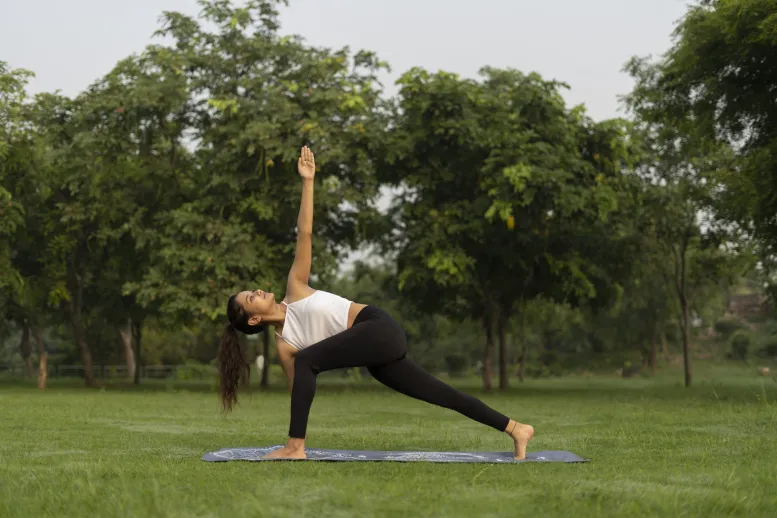
Extended Side Angle pose strengthens the legs, stretches the groin and hips, and engages the core. It also improves balance and stability while opening the chest and shoulders. This pose enhances overall body strength and flexibility, making it beneficial for climbers.
4. Garland Pose (Malasana)
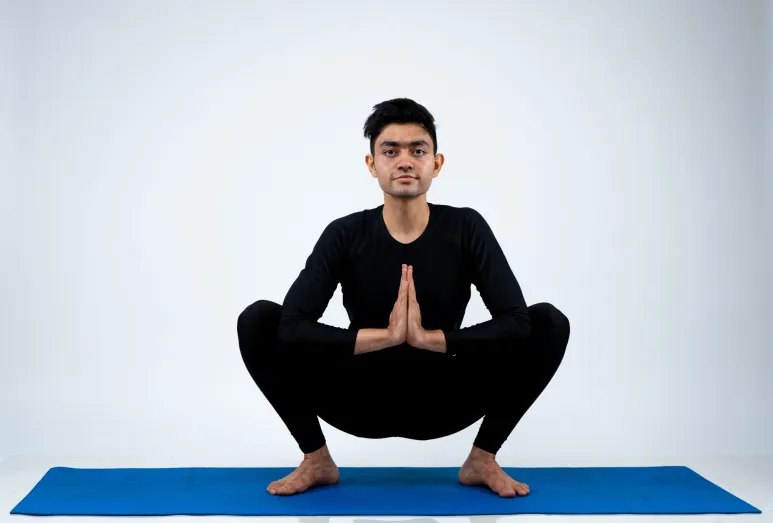
Garland Pose is a deep squat that stretches the hips, ankles, and lower back. It helps to increase flexibility in the hips and groin, which can improve a climber’s ability to move dynamically and with agility on the wall.
5. Boat Pose (Navasana)
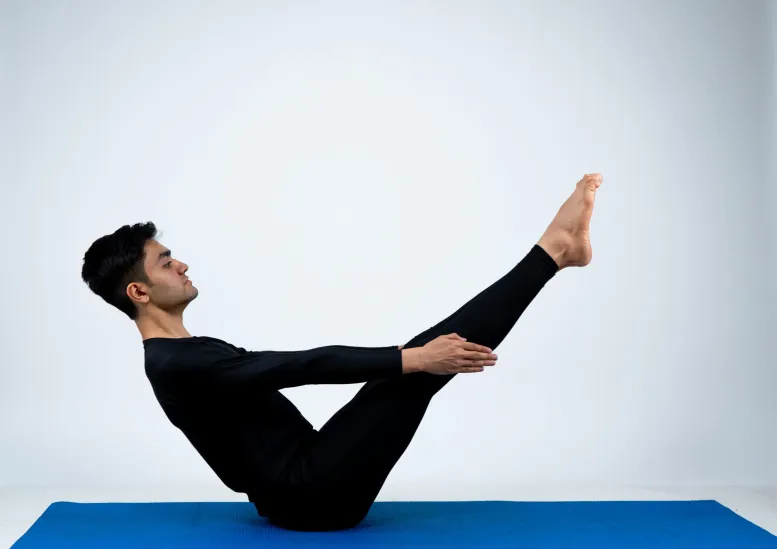
Boat Pose targets the core muscles, strengthening the abdominals and lower back. A strong core is crucial for maintaining stability and balance during climbs. Practicing Boat Pose can also improve overall body control and prevent injuries.
6. Eagle Pose (Garudasana)
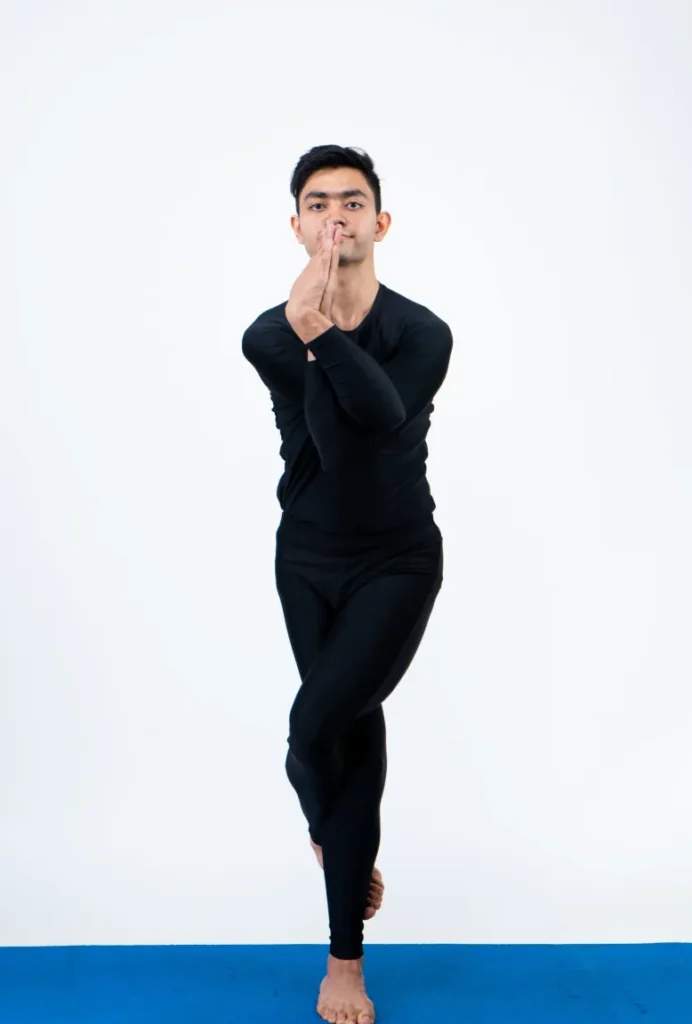
Eagle Pose is a balancing pose that stretches the shoulders, upper back, and hips. It helps improve shoulder mobility and strengthens the muscles around the shoulder blades, aiding climbers in executing intricate movements and maintaining proper posture on the wall.
Developing a Yoga and Climbing Routine
To effectively incorporate yoga into your climbing routine, consider the following tips:
1. Warm-up with Dynamic Movements
Before starting your yoga practice, warm up your body with dynamic movements like arm circles, leg swings, and gentle twists. This prepares the muscles for deeper stretching and reduces the risk of injury.
2. Combine Strength and Flexibility
Include a balance of strength-building and flexibility-focused poses in your yoga practice. This combination will help you develop the necessary physical qualities for climbing while improving overall mobility.
3. Focus on Breath Awareness
During your yoga practice, pay attention to your breath. Use slow, deep breaths to calm the mind, increase oxygen flow, and improve your focus. This breath awareness can also be transferred to your climbing, helping you stay centered and in control.
4. Practice Mindfulness Meditation
Incorporate mindfulness meditation into your yoga practice or as a separate practice altogether. This can be done by sitting quietly, focusing on your breath, and observing your thoughts without judgment. Cultivating mindfulness can enhance your mental resilience and concentration while climbing.
5. Listen to Your Body
Always listen to your body’s signals during your yoga practice and climbing sessions. Respect your limits and avoid pushing yourself too hard, as this may lead to overexertion or injury. Modify poses as needed and gradually progress at a pace that feels comfortable for you.
Yoga for Climbers: A Balanced Diet for Optimal Performance
In addition to incorporating yoga into your climbing routine, maintaining a balanced and nutritious diet is essential for supporting your physical and mental well-being. Here’s a table outlining a sample diet plan for climbers:
| Meal | Foods |
|---|---|
| Breakfast | Scrambled eggs, whole-grain toast, avocado |
| Fresh fruit | |
| Greek yogurt | |
| Nut butter | |
| Herbal tea or green tea | |
| Mid-Morning Snack | Mixed nuts |
| Energy bar | |
| Fresh berries | |
| Lunch | Quinoa salad with grilled chicken |
| Mixed greens | |
| Cherry tomatoes | |
| Cucumber | |
| Lemon vinaigrette dressing | |
| Afternoon Snack | Hummus with carrot and celery sticks |
| Rice cakes | |
| Pre-Climbing | Banana |
| Snack | Peanut butter |
| Energy gel or sports drink | |
| Dinner | Grilled salmon |
| Roasted sweet potatoes | |
| Steamed broccoli | |
| Quinoa or brown rice | |
| Evening Snack | Greek yogurt with honey and granola |
| Before Bed | Herbal tea |
It’s important to remember that individual nutritional needs may vary. Consult with a registered dietitian or nutritionist to customize a diet plan that suits your specific requirements.
Hydration Tips for Climbers
Staying properly hydrated is crucial for climbers to maintain optimal performance and prevent fatigue. Here are some hydration tips to keep in mind:
- Drink water consistently throughout the day, not just during climbing sessions.
- Carry a reusable water bottle with you and sip water regularly.
- Hydrate before, during, and after climbing sessions to replenish lost fluids.
- Consider sports drinks or electrolyte-enhanced water to replace electrolytes lost through sweat.
- Monitor the color of your urine; pale yellow or clear urine indicates good hydration.
Managing Vertigo for Climbers
Vertigo, a sensation of dizziness or spinning, can pose challenges for climbers. Here are some tips to manage vertigo and maintain your climbing performance:
- Consult a healthcare professional: If you experience persistent or severe vertigo symptoms, it’s important to consult a healthcare professional for a proper diagnosis and guidance.
- Practice balance exercises: Engage in specific balance exercises to improve your stability and reduce the frequency and intensity of vertigo episodes. Yoga poses like Tree Pose (Vrikshasana) and Warrior III (Virabhadrasana III) can help strengthen your balance and focus.
- Manage stress and anxiety: Stress and anxiety can exacerbate vertigo symptoms. Incorporating stress management techniques such as deep breathing exercises, meditation, and mindfulness practices into your daily routine can help reduce anxiety levels and promote overall well-being.
- Stay hydrated: Dehydration can contribute to dizziness and exacerbate vertigo symptoms. Ensure you stay properly hydrated before, during, and after climbing sessions to support your body’s balance and function.
- Take breaks and pace yourself: Recognize your limits and take breaks during climbing sessions. Pushing yourself too hard can increase the risk of vertigo episodes. Pace yourself and listen to your body’s signals to avoid overexertion.
- Avoid sudden head movements: Rapid head movements can trigger or worsen vertigo symptoms. Take care to move your head slowly and deliberately, especially during climbs that involve looking up or down.
- Use appropriate safety gear: Ensure you use appropriate safety gear, such as helmets, while climbing to minimize the risk of head injuries. Protecting your head can reduce the potential impact on your vestibular system, which plays a role in maintaining balance.
- Focus on breathing and mindfulness: During challenging climbs, focusing on your breath and maintaining a mindful state can help distract from vertigo sensations and improve your ability to stay present and focused.
- Gradually expose yourself to heights: If you experience vertigo specifically when exposed to heights, consider gradual exposure therapy. Start with lower heights and progressively work your way up, allowing your body to adapt and reduce the intensity of vertigo symptoms.
- Seek support from fellow climbers: Connect with fellow climbers who have experience managing vertigo. They may provide helpful tips, strategies, and support as you navigate your climbing journey while dealing with vertigo.
Remember, while these tips may assist in managing vertigo, it’s essential to consult with a healthcare professional for personalized advice and guidance based on your specific condition.
Safety Measures for Climbers with Vertigo
When dealing with vertigo as a climber, it’s important to prioritize safety to minimize the risk of accidents or injuries. Here are some additional safety measures to consider:
- Choose appropriate climbing routes: opt for climbing routes that are well within your comfort zone and avoid routes that have significant exposure or heights that may trigger your vertigo. Start with easier climbs and gradually progress as you build confidence and manage your symptoms.
- Climb with a partner: Always climb with a trusted partner who is aware of your vertigo condition. They can provide assistance, support, and help ensure your safety during climbs. Communicate openly with your partner about your condition and any specific concerns you may have.
- Take breaks on secure ledges: When climbing, if you feel a vertigo episode coming on, find a secure ledge or resting spot where you can take a break and regain your balance. Use this time to breathe deeply, focus on a fixed point, and allow the vertigo sensation to subside before continuing.
- Consider top-roping or bouldering: If exposure to heights triggers your vertigo, consider focusing on top-roping or bouldering, which involve climbing closer to the ground. These activities can still provide a challenging climbing experience while minimizing the potential for vertigo-related symptoms.
- Use a safety harness and gear: Ensure you are properly equipped with a safety harness, helmet, and appropriate climbing gear. The use of safety equipment adds an extra layer of protection in case of a fall or loss of balance.
- Be mindful of the environment: Pay attention to environmental factors that may exacerbate your vertigo symptoms, such as high winds or uneven terrain. Assess the conditions before starting a climb and make informed decisions about whether to proceed or wait for more favorable conditions.
- Gradually increase exposure to heights: If you are determined to overcome your fear of heights and manage your vertigo, consider gradually exposing yourself to heights in controlled environments. Seek the guidance of a qualified climbing instructor who can provide appropriate guidance and support during your progression.
- Communicate with your climbing community: Inform your climbing community, including instructors and fellow climbers, about your vertigo condition. They can offer support, understanding, and potentially suggest strategies or alternative routes that may be more suitable for you.
Remember, safety should always be your top priority. Be patient with yourself, listen to your body, and make decisions that prioritize your well-being during your climbing adventure.
FAQs
1. Can yoga help prevent climbing injuries?
Yes, yoga can help prevent climbing injuries by improving strength, flexibility, and body awareness. It can also aid in recovery and reduce the risk of overuse injuries.
2. Is yoga suitable for climbers of all levels?
Yes, yoga is beneficial for climbers of all levels, from beginners to advanced. Poses and sequences can be modified to accommodate different skill levels and physical abilities.
3. How often should climbers practice yoga?
Ideally, incorporating yoga into your climbing routine two to three times a week can yield significant benefits. However, even one yoga session per week can provide noticeable improvements over time.
4. Can yoga improve my mental focus while climbing?
Yes, yoga can improve mental focus through mindfulness practices and breath control techniques. These skills can help you stay present, manage fear, and make better decisions while climbing.
5. How long should a yoga session be for climbers?
The duration of a yoga session can vary depending on your schedule and needs. Aim for at least 30 minutes to an hour, but even shorter sessions can be beneficial if done consistently.
6. Can yoga help with finger and grip strength for climbers?
While yoga primarily focuses on overall strength and flexibility, certain poses and movements can indirectly help improve finger and grip strength by engaging the muscles of the hands and forearms.
7. Can yoga help with fear and anxiety while climbing?
Yes, the combination of mindfulness practices, breath control, and body awareness cultivated through yoga can help climbers manage fear, anxiety, and performance-related stress. It promotes a sense of calm and focus.
8. Is it necessary to be flexible to practice yoga for climbing?
No, flexibility is not a prerequisite for practicing yoga. Yoga can help improve flexibility over time, and modifications can be made to accommodate different levels of flexibility.
9. Should I do yoga before or after climbing?
It can be beneficial to do a short yoga warm-up before climbing to prepare the body and mind. After climbing, a longer yoga session focused on stretching and recovery can help release tension and promote muscle repair.
10. Can yoga help prevent common climbing injuries, such as tendonitis?
Yoga can aid in injury prevention by strengthening muscles, improving flexibility, and promoting proper body alignment. However, it’s important to practice proper climbing technique and listen to your body to avoid overuse injuries.
Incorporating yoga into your climbing routine can enhance your strength, flexibility, mental focus, and overall climbing performance. Embrace the practice of yoga and enjoy the transformative benefits it brings to your climbing journey.
